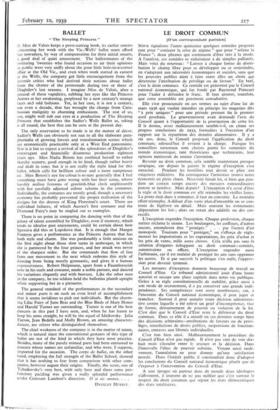BALLET
‘, The Sleeping Princess"
Jr Miss de Valois keeps a press-cutting book, its earlier entries concerning her work with the Vic.-Wells' ballet must afford her nowadays, by way of compensation for their initial smarts, a good deal of quiet amusement. The balletomanes of the twittering 'twenties who found occasion to air their opinions in public were very sniffy about the poor little hole-in-a-corner affair at the Old Vic., and even when work started in earnest at the Wells, the company got little encouragement from the juvenile critics who had derived their notions about ballet from the chatter of the promenade during two or three of Diaghilev's last seasons. I imagine Miss de Valois, after a perusal of these vapidities, rubbing her eyes like the Princess Aurora at her awakening, perplexed by a new century's strange faces ani odd fashions. Yet, in her case, it is not a century, not even a decade, that has wrought the change from Cara- bossian malignity to charming enthusiasm. The rest of us, too, might well rub our eyes at a production of The Sleeping Princess that establishes the Sadler's Wells Ballet as, taking it all round, the best that can be seen at the present day.
The only reservation to be made is in the matter of decor. Sadler's Wells can obviously not run to all the elaborate para- phernalia of growing forests and transformation scenes which are economically practicable only at a West End pantomime. Nor is it fair to expect a revival of the splendours of Diaghilev's extravagant and financially disastrous production eighteen years ago. Miss Nadia Benois has confined herself to rather sketchy scenery, good enough in its kind, though rather heavy and drab in tone; but it is not really the right kind for this ballet, which calls for brilliant colour and a more sumptuous air. Miss Benois's eye for colour is so sure generally that I feel something must have gone wrong with her final scene, whose harshly aniline festoons of greenish-blue clash unpleasantly with her carefully adjusted colour scheme in the costumes. Individually, the costumes are mostly good, though a necessary economy has probably prevented the proper realisation of the designs for the dresses of King Florestan's court. There are individual failures, of which Aurora's first costume and the Diamond Fairy's may be singled out as examples.
There is no point in comparing the dancing with that of the galaxy of talent assembled by Diaghilev, even if memory, which tends to idealise past enjoyments, could be certain about how Spessiva did this or Lopokova that. It is enough that Margot Fonteyn gives a performance as the Princess Aurora that has both style and charm. She was pardonably a little anxious on the first night about those slow turns in arabesque, in which she is partnered by the four princes, and her attack was never of the sharpest order. But she commands that flow of line from one movement to the next which redeems this style of dancing from being merely gymnastic, and gives it a human expressiveness. Robert Helpmann, apart from a Fauntleroyish note in his curls and costume, made a noble partner, and danced his variations elegantly and with bravura. Like the other men in the company, he too seldom held the ballerina plumb upright when supporting her in a pirouette.
The general standard of the performances in the secondary and minor parts is on such an even level of accomplishment that it seems invidious to pick out individuals. But the charm- ing Lilac Fairy of June Brae and the Blue Birds of Mary Honer and Harold Turner are outstanding. Turner is one of the best dancers in this part I have seen, and, when he has learnt to keep his arms straight, he will be the equal of Idzikovsky. Julia Farron, Jean Bedells and Molly Brown, an amusing character- dancer, are others who distinguished themselves.
The chief weakness of the company is in the matter of mime, which is natural since the conventional gestures of this type of ballet are not of the kind in which they have most practice. Besides, many of the purely mimed parts had been entrusted to dancers whose names are unfamiliar, and who were, I suppose, imported for the occasion. The corps de ballet, on the other hand, employing the full strength of the Ballet School, showed that it has nothing to fear from comparison with other com- panies, however august their origins. Finally, the score, one of Tchaikovsky's very best, with only here and there some per- functory padding was given a really splendid performance under Constant Lambert's direction. 0 si sic omnes. . . .
DYNELEY HUSSEY.














































 Previous page
Previous page